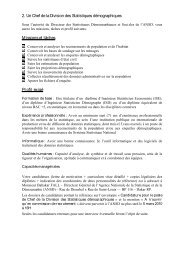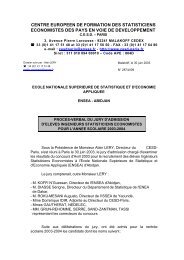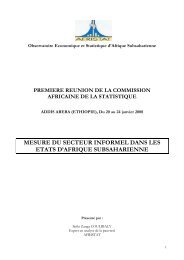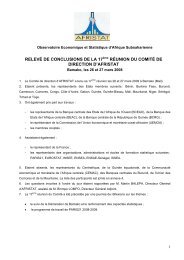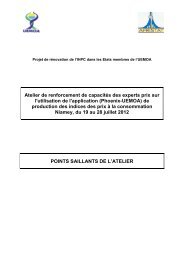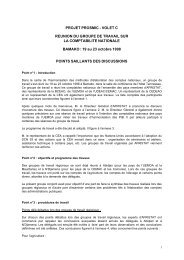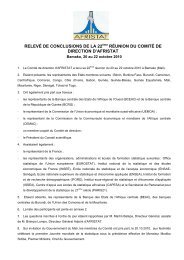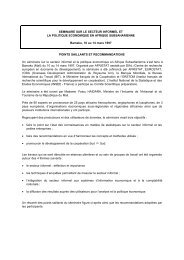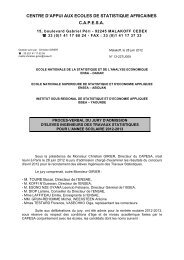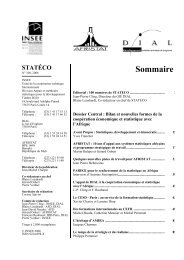Global Purchasing Power Parities and Real Expenditures - Afristat
Global Purchasing Power Parities and Real Expenditures - Afristat
Global Purchasing Power Parities and Real Expenditures - Afristat
You also want an ePaper? Increase the reach of your titles
YUMPU automatically turns print PDFs into web optimized ePapers that Google loves.
186 <strong>Global</strong> <strong>Purchasing</strong> <strong>Power</strong> <strong>Parities</strong> <strong>and</strong> <strong>Real</strong> <strong>Expenditures</strong>rental services per capita. This makes rental services neutralbecause it does not disturb the per capita volumes for privatehousehold consumption <strong>and</strong> also assumes that the volumesof rental services rise in line with overall expenditures. Thereference volume approach is rooted in the observations ofthe behavior of housing services for large groups of economies.Table F2 shows the real expenditures per capita byregion, for both private consumption <strong>and</strong> housing, whichwere obtained using a uniform-quantity approach, withquality corrections based on 106 economies.The other regions used either rental surveys or quantitycomparisons (or a combination) to compare rentalservices; therefore, one problem was how to link housingacross regions. The method adopted was to use qualityadjustedquantities across the regions, based on data from106 economies (see Heston, Multilateral Housing Comparisons).This linking was independent of how the regionalPPPs were derived. For example, other consumption basicheadings were linked by deflating the ring prices by thewithin-region PPPs, then computing the between-regionPPPs. The between-region housing PPPs were computeddirectly using the quantity-quality data from the 106 economies.The regional total real expenditures as determinedby the quantity approach were distributed to countrieswithin region to observe fixity. This is a somewhat differentmethod from that used in earlier comparisons, whichwill hopefully be improved in the future. However, it doesmean that users need to underst<strong>and</strong> that this affects thecomparability of rental services when comparing economiesin Asia-Pacific <strong>and</strong> Africa with economies in otherregions. <strong>Real</strong> expenditures for rental services could beunderestimated in economies where both per capita rentalservices <strong>and</strong> household consumption are below the respectiveregional averages—<strong>and</strong> overestimated where both areabove the average.Compensation: General GovernmentThe services of civil servants <strong>and</strong> health <strong>and</strong> educationemployees are typically not priced; rather, the input costapproach was used. Reference PPPs were used for intermediateconsumption <strong>and</strong> consumption of fixed capital. PPPsfor compensation were derived from a detailed comparisonTable F2<strong>Real</strong> <strong>Expenditures</strong> per Capitaof salaries for specific occupations. It was recognized thatthis procedure assumed equal productivity across economiesfor a given occupation, which was unlikely, given verydifferent amounts of capital per worker. Further, very lowwageeconomies have less incentive to organize work tosave labor, including those in administrative, health, <strong>and</strong>education services. In the 2005 benchmark, the range ofeconomies was much greater than in previous rounds, <strong>and</strong>some consequences of the equal-productivity assumptionloomed much larger. In Asia-Pacific, for example, salariesfor the same occupation differ by a factor of 100 betweenVietnam <strong>and</strong> Hong Kong (China). Similar differencesexisted between Yemen <strong>and</strong> Kuwait in the Western Asiacomparison <strong>and</strong> between the richer <strong>and</strong> poorer countriesin Africa. Without some adjustment for productivity, theresulting per capita volumes in Yemen or Vietnam wouldbe greatly distorted compared with those of its richerneighbors. In contrast, salary differences in South Americadid not exceed a factor of three.real expenditures per capita(world = 100%)Housing, water, Individualelectricity, gas, householdICP regions <strong>and</strong> other fuels consumption(percent) (percent)Asia-Pacific 28.2 32.3South America 83.3 90.8Eurostat-OECD 325.5 317.5Africa 26.8 24.8Western Asia 44.7 60.4Source: ICP global office.Asia-Pacific, Western Asia, <strong>and</strong> Africa adjusted the averagesalaries of each economy for productivity based on estimatesof the capital-to-labor ratio in each economy. Thisposes a problem of comparability across regions <strong>and</strong> for



